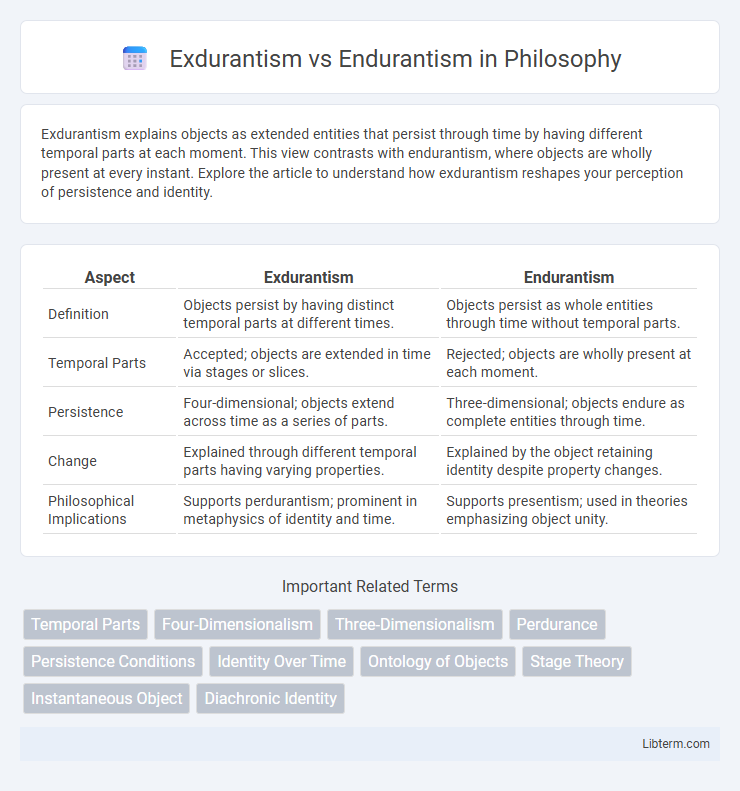Exdurantism explains objects as extended entities that persist through time by having different temporal parts at each moment. This view contrasts with endurantism, where objects are wholly present at every instant. Explore the article to understand how exdurantism reshapes your perception of persistence and identity.
Table of Comparison
| Aspect | Exdurantism | Endurantism |
|---|---|---|
| Definition | Objects persist by having distinct temporal parts at different times. | Objects persist as whole entities through time without temporal parts. |
| Temporal Parts | Accepted; objects are extended in time via stages or slices. | Rejected; objects are wholly present at each moment. |
| Persistence | Four-dimensional; objects extend across time as a series of parts. | Three-dimensional; objects endure as complete entities through time. |
| Change | Explained through different temporal parts having varying properties. | Explained by the object retaining identity despite property changes. |
| Philosophical Implications | Supports perdurantism; prominent in metaphysics of identity and time. | Supports presentism; used in theories emphasizing object unity. |
Introduction to Exdurantism and Endurantism
Exdurantism and Endurantism are two prominent metaphysical theories addressing the persistence of objects through time. Exdurantism, also known as stage theory, posits that objects are temporal stages or slices that exist at particular times, with an object's persistence constituted by a series of these distinct temporal parts. Endurantism, in contrast, argues that objects are wholly present at every moment of their existence, maintaining identity by enduring through time without being divided into temporal parts.
Defining Exdurantism: The Stage Theory
Exdurantism, also known as the Stage Theory, defines objects as temporal stages rather than enduring entities persisting wholly through time. Each stage represents an object at a specific moment, with persistence explained by temporal relations between these distinct stages. This framework contrasts with endurantism by emphasizing temporal parts and accommodating change without requiring objects to be wholly present at every instant.
Understanding Endurantism: The Endurance Theory
Endurantism, also known as the endurance theory, posits that objects are wholly present at every moment of their existence, maintaining their identity through time without temporal parts. This theory contrasts with perdurantism by rejecting the idea that objects are extended in time as series of temporal stages or parts. Understanding endurantism is crucial for addressing metaphysical issues related to persistence, identity, and change, emphasizing the continuous and unchanging presence of entities throughout their temporal duration.
Historical Background and Philosophical Roots
Exdurantism, rooted in the 20th-century philosophy of persistence, contrasts with endurantism, which traces back to ancient metaphysical traditions emphasizing object permanence through time. Endurantism finds its origins in Aristotelian substance theory, asserting objects are wholly present at every moment, while exdurantism, influenced by temporal logic and four-dimensionalism, views objects as extended in time with temporal parts. Philosophers like J.M.E. McTaggart and David Lewis significantly contributed to the development of exdurantism, challenging classical notions of identity and persistence.
Key Differences Between Exdurantism and Endurantism
Exdurantism posits that objects are extended in time by having different temporal parts at different times, whereas endurantism holds that objects are wholly present at each moment of their existence. Exdurantism explains change and persistence through temporal parts, enabling distinct stages of an object across time, while endurantism emphasizes an object's continuous identity without temporal segmentation. This fundamental difference impacts how philosophers approach identity, change, and the metaphysics of time.
Persistence Through Time: How Objects Exist
Exdurantism posits that objects persist by having different temporal parts at different times, meaning they are extended in time much like they are in space. Endurantism maintains that objects are wholly present at each moment of their existence, enduring through time without having distinct temporal parts. This fundamental difference shapes how each theory explains an object's identity and change across time.
Famous Philosophers and Major Contributions
Exdurantism, also known as the perdurantist view, is prominently supported by philosophers like David Lewis, who argued for objects as four-dimensional entities extended through time with temporal parts. Endurantism, favored by thinkers such as Aristotle and contemporary philosopher David Wiggins, holds that objects are wholly present at every moment of their existence without temporal parts. Major contributions include Lewis's modal realism framing perdurantism within possible worlds semantics, and Wiggins's defense of endurantism emphasizing the persistence of identity through change.
Arguments Supporting Exdurantism
Exdurantism argues that objects are four-dimensional entities extended in time, composed of temporal parts or stages, which explains persistence through change more coherently than endurantism's wholly present objects at each time. This perspective addresses the problem of temporary intrinsics by positing that an object's properties can vary across different temporal parts without contradiction. It also aligns with the physics of spacetime, offering a model consistent with relativity by treating objects as spacetime worms rather than enduring three-dimensional beings.
Arguments Supporting Endurantism
Endurantism asserts that objects are wholly present at every moment of their existence, supporting the view that persistence involves enduring through time as complete entities. This perspective addresses the problem of temporary intrinsics by maintaining that an object's properties remain constant despite changes, resolving issues raised by the alternatives in perdurantism. Endurantism aligns with common intuitions about identity and offers a coherent framework for understanding how objects persist without fragmenting into temporal parts.
Contemporary Debates and Future Directions
Contemporary debates in Exdurantism vs Endurantism center on issues of temporal ontology, with Exdurantists emphasizing objects as temporal parts spread across time while Endurantists argue for wholly present entities at each moment. Recent philosophical discussions engage with implications for persistence, identity, and change, incorporating insights from metaphysics and the philosophy of time. Future directions involve integrating findings from cognitive science and physics to refine models of temporal existence and address challenges posed by relativistic and quantum frameworks.
Exdurantism Infographic

 libterm.com
libterm.com